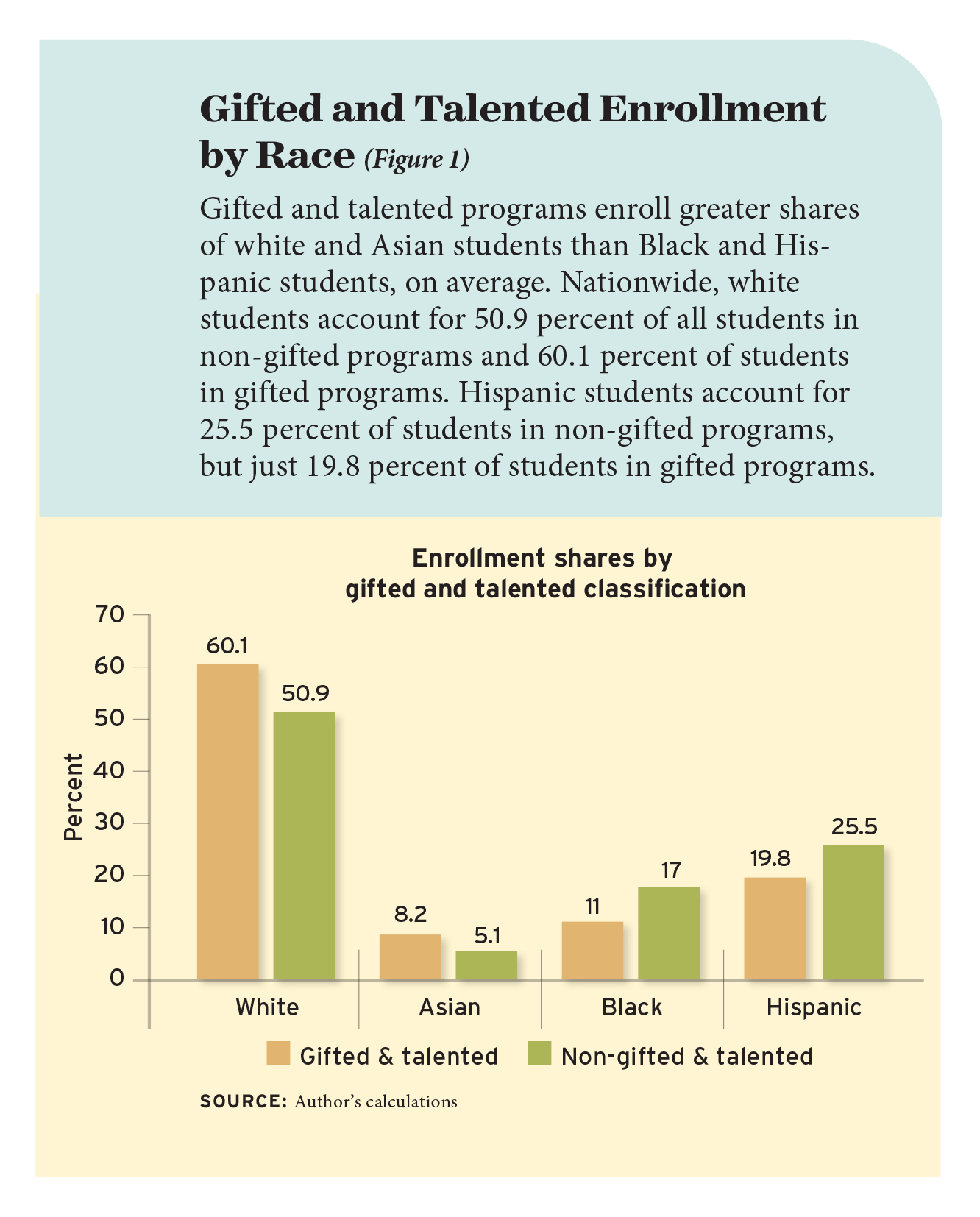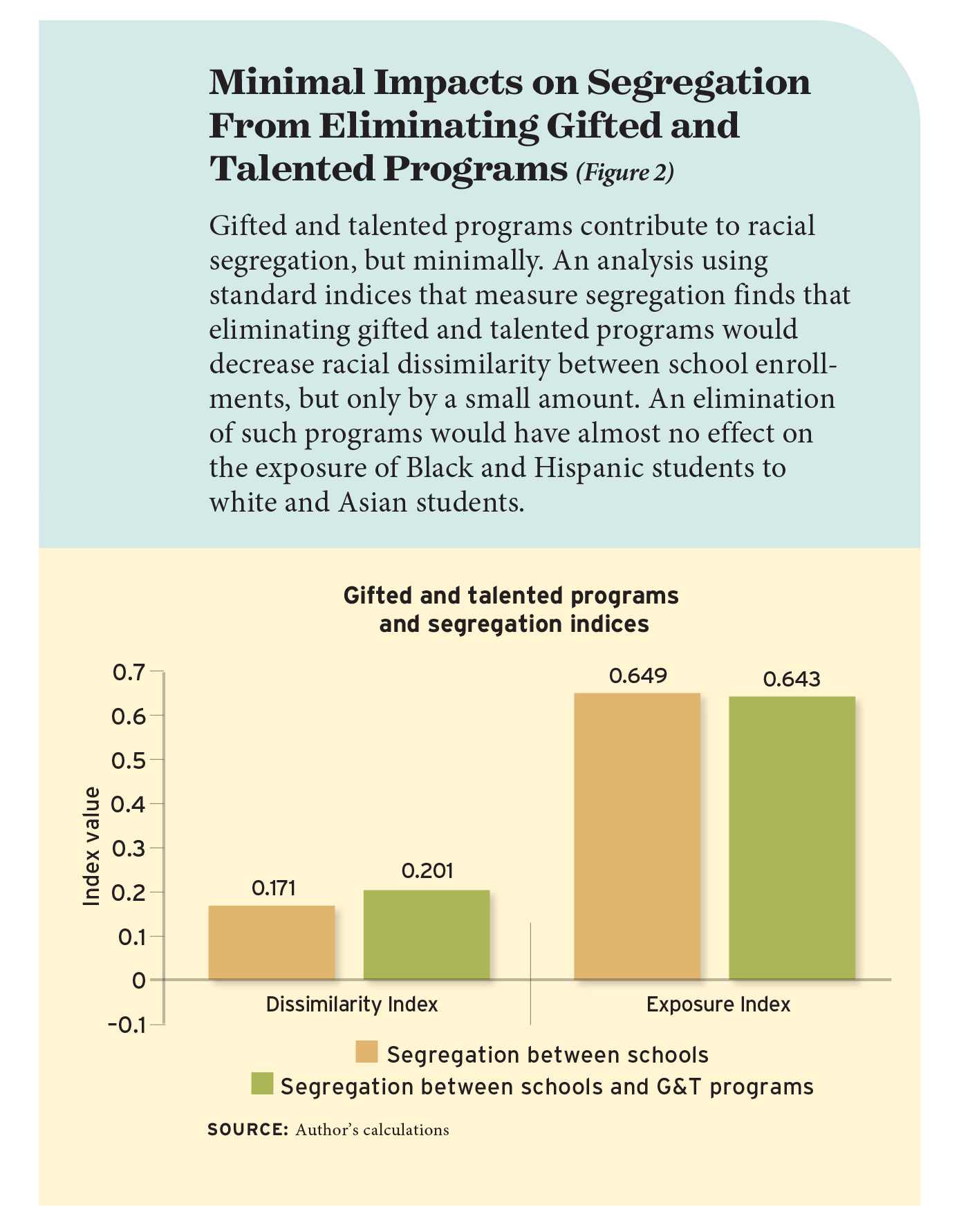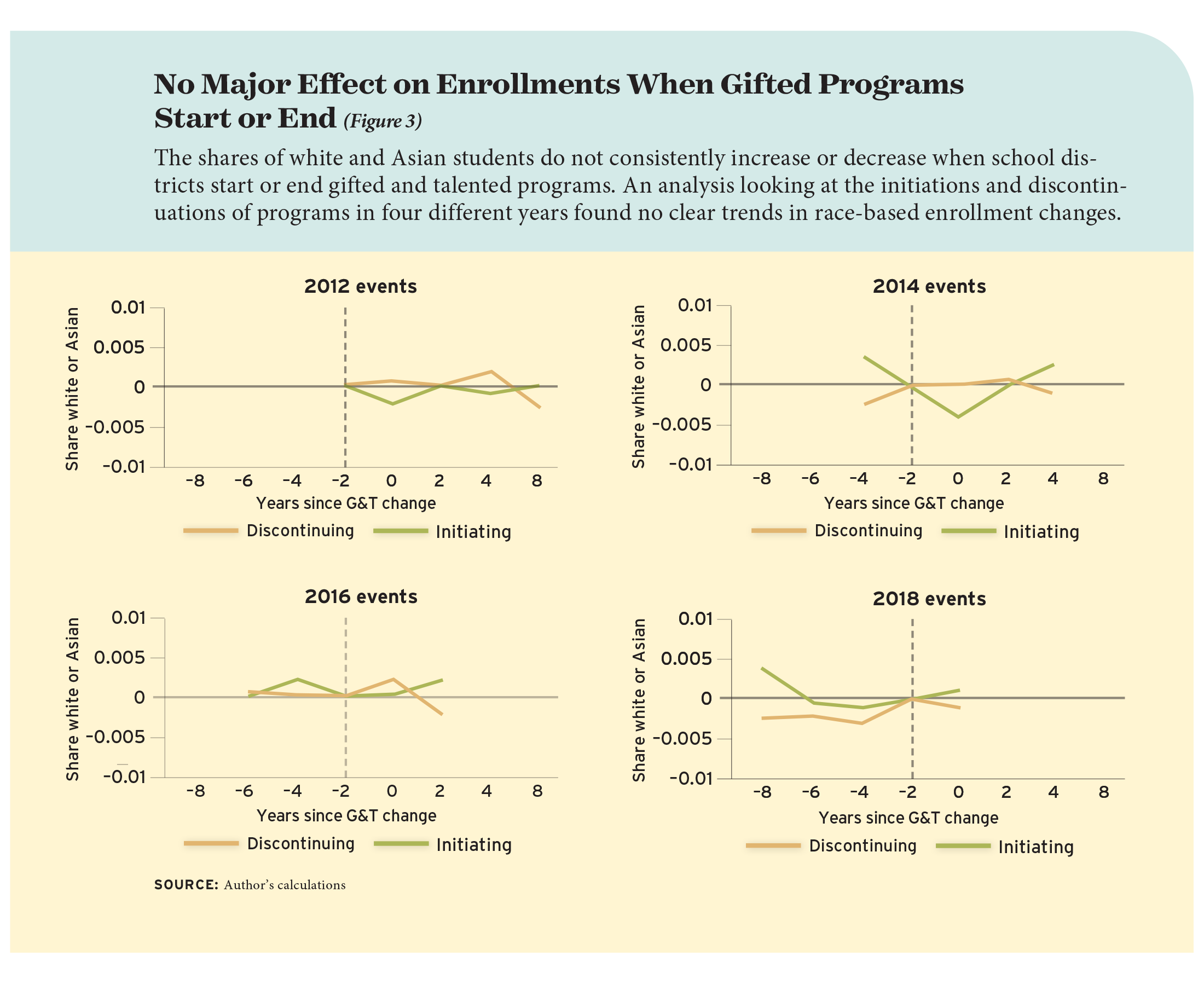
For decades, gifted and talented programs have offered small, selected groups of students enrichment and faster-paced lessons. They also have stoked controversy and allegations of contributing to racial segregation and academic inequality. New York City’s program, for example, was planned for virtual elimination in 2021 based on longstanding concerns about relatively low enrollment rates for Black and Latino students, who account for about 70 percent of all city students but 25 percent of gifted and talented students. After public outcry, the program was preserved, but with major changes: more classes, including in less-advantaged neighborhoods, and more pathways for students to qualify.
Racial segregation and racial gaps in student achievement in U.S. public schools are well-documented trends. So too are race-based differences in student enrollment in general-education versus gifted and talented programs. But are gifted and talented programs drivers of racial segregation? If so, to what extent?
To explore these questions, I look at the federal education department’s Civil Rights Data Collection surveys, which provide detailed data on the existence and racial composition of gifted and talented programs at virtually every elementary school in the United States. I focus on the period between 2009 to 2018 to investigate and compare the racial compositions of gifted and talented and general-education programs. I then apply standard indices of racial segregation to determine the extent to which gifted programs contribute to within-school segregation.
Overall, gifted and talented programs do disproportionately enroll more white and Asian students and fewer Black and Hispanic students. However, they have only a minor impact on racial segregation, in part because they enroll relatively small numbers of American schoolchildren. When I track enrollment changes at specific elementary schools before and after gifted programs are initiated or discontinued, I find virtually no impact on the percentages of white and Asian students. Gifted and talented programs are not a major contributor to racial segregation in U.S. elementary schools.
Who Is Gifted?
Gifted and talented programs have been a feature of American public schools for nearly a century. Nationwide, these programs enroll a relatively small share of students. In 2017–18, for example, 1.6 million elementary-school students were enrolled in gifted programs out of 23.6 million students overall, or 6.9 percent of total enrollment.
There is no single standard definition of giftedness. Instead, states and school districts apply locally selected measures of intelligence and ability to determine which students are accelerated relative to their peers. These encompass a broad spectrum of approaches: IQ, demonstrated ability in multiple intelligences, creativity and problem solving, and focus and task commitment. Some programs use screening tests to determine entry, while others are based on teacher recommendation and portfolio review.
The structures and operations of gifted and talented programs are similarly diverse. While no official data is collected on their basic operations, a 2019 national survey of more than 1,200 gifted and talented teachers and coordinators conducted by Education Week provides some insight into common practices.
The survey found that the most common method of delivering gifted and talented instruction was in “pull-outs,” where identified students are removed from the mainstream classroom for a portion of instructional time. Some 86 percent of gifted and talented educators reported using pull-outs compared to 32 percent reporting self-contained classrooms. The most common gifted and talented services were “content enrichment,” where instruction provided deeper coverage of grade-level topics, and “content acceleration,” in which students moved more quickly to new topics compared to their general-education peers down the hall.
There is little question that segregationists historically used within-school tracking programs like gifted and talented education as an intentional strategy to subvert legally required school integration. Many school districts in the South initiated test-based classroom assignments in the wake of strong school desegregation enforcement in the 1970s, for example. While many of these programs were successfully challenged in the courts, the general practice of ability grouping was not itself ruled unconstitutional.
Contemporary implementations of gifted and talented programming are rarely seen as explicit attempts to resurrect de jure racial segregation. But racial gaps in tests scores, as well as other common features of gifted and talented screening processes, such as the availability of fee-based aptitude test-score prep programs, have the strong potential to result in de facto racial imbalances in gifted and talented programs and contribute to overall racial segregation. In addition, research suggests that many common screening processes are subject to some degree of racial bias; for example, Jason Grissom and Christopher Redding found that Black students with high tests scores are less likely than similar non-Black students to be referred to gifted programs, especially when they are taught by a non-Black teacher.

Data and Method
My analysis is based on data from the U.S. Department of Education’s Civil Rights Data Collection surveys, which are conducted biennially and are mandatory for virtually every public school in the country. I focus on the five surveys administered from 2009–10 to 2017–18, which included consistent data about gifted and talented programs. These surveys collect information on a wide variety of school characteristics including enrollment, discipline, teacher characteristics, expenditures, and curricular offerings, and most of the data is disaggregated by student race and ethnicity, sex, English proficiency, and disability status. For this analysis, I consider only whether the school operated a gifted and talented program in each year, as well as the race-specific enrollments of the gifted and talented program (when present) and of the full school. I include public charter, magnet, and alternative schools offering any grade from K through 6 in all 50 states plus Washington, D.C., but not schools that offered only a special education curriculum or were not observed in all five surveys. The resulting data set includes 46,704 public elementary schools observed five times over a span of nine school years.
I calculate race-specific enrollments using the racial and ethnic categorizations that were collected in a consistent fashion across all survey years. I divide enrollment into two main groups: Hispanic and Black students, and white and Asian students. (The group of Hispanic and Black students also includes a small number of Native American students.) This allows me to identify racial differences in gifted and talented program enrollments and analyze how the racial composition of those programs affects racial segregation between and within schools.
Enrollment rates by race confirm that widely held perceptions about gifted and talented programs are correct. These programs disproportionately enroll white and Asian students compared to Black and Hispanic students.
Nationwide, the average gifted and talented program enrolls 60.1 percent white students and 8.2 percent Asian students. These students account for smaller shares of enrollment in non-gifted programs: 50.9 percent and 5.1 percent, respectively (see Figure 1). The opposite is true of Black and Hispanic students: Black students account for 11 percent of gifted and talented students but 17 percent of non-gifted enrollments, while Hispanic students account for 19.8 percent of gifted and talented students but 25.5 percent of non-gifted enrollments.
Because the racial composition of many gifted and talented programs does not resemble schools’ overall enrollment, critics have argued that such programs essentially constitute independent, racially segregated programs within supposedly integrated schools. This argument holds that standard between-school segregation measures substantially understate the true level of racial segregation within schools, and that eliminating gifted and talented programs therefore could be an effective desegregation strategy.
To evaluate this claim, I calculate two standard indices of segregation for all schools in the sample. I then do the same calculations as if gifted and talented programs are standalone, separate schools, to see how much gifted and talented programs contribute to racial segregation within schools.
First, I calculate the dissimilarity index. When applied to schools, this index measures how evenly members of different racial groups are distributed across different schools relative to a district’s overall enrollment. It can be interpreted as the share of students from one school who would need to move to another school in order to make the racial composition of each school match that of the district as a whole. The dissimilarity index therefore ranges from 0 to 1, with larger values indicating greater segregation.
Then I calculate the exposure index, which measures how intensively one group of students is exposed to another group. It can be interpreted as the probability among members of one racial group that a randomly selected peer will be from a different racial group. My analysis focuses on the exposure of Black and Hispanic students to white and Asian students, such that the exposure index values give the share of Black and Asian students’ peers who are white or Asian. Note that unlike the dissimilarity index, larger values indicate less segregation.
To isolate the influence of gifted and talented programs on racial segregation, I first calculate these two indices between all elementary schools in the same district. I then re-calculate each index between all elementary schools and all gifted and talented programs within the same district. The latter measure therefore reflects both between-school segregation and any within-school segregation that results from gifted and talented programs. Finally, I calculate the difference between the two measures for both indices, which shows how racial segregation would change if gifted and talented programs were discontinued and those students returned to non-gifted classrooms at their schools.

Results
Gifted and talented programs do contribute to racial segregation—but not by very much. In looking at school districts that have gifted and talented programs, which includes about 70 percent of the total dataset, my analysis indicates that if these programs were ended and gifted students were returned to non-gifted classrooms, the value of the dissimilarity index would decline by about 0.03, or approximately 18 percent of its mean value.
Overall, racial dissimilarity between all public elementary schools in districts that have gifted and talented programs is 0.171 (see Figure 2). When I recalculate that index as though gifted and talented programs were their own separate schools, racial dissimilarity increases to 0.201. However, because most gifted programs operate as occasional pullouts, rather than standalone classrooms, this estimate likely overstates their contribution to racial segregation.
I also conduct the same calculations for all U.S. school districts, including those that do not have gifted programs. Racial dissimilarity between schools is 0.151 overall and 0.172 when gifted and talented programs are included in the analysis as separate schools, a difference of 0.021. Finally, I calculate dissimilarity for larger, diverse U.S. districts, which I define as serving more than 35,000 students and where Black and Hispanic students make up between 10 percent and 90 percent of enrollment. In these districts, racial dissimilarity is 0.439 overall and 0.452 when gifted and talented programs are included as separate schools, a difference of 0.013.
In looking at the exposure index, I find essentially no impact from gifted and talented programs on a Black or Hispanic student’s likelihood of having white or Asian students as classmates. In districts that have gifted and talented programs, the overall exposure index is 0.649. The exposure index is 0.643 when gifted and talented programs are included as separate schools, a difference of -0.006.
This may seem incongruent with the overrepresentation of white and Asian students in gifted and talented programs. However, remember that gifted and talented programs account for only 6.9 percent of total school enrollments, a relatively small share. In addition, 27.3 percent of gifted students are Black and Hispanic. While that is a smaller percentage than overall Black and Hispanic enrollment of 47.7 percent, it is still a substantial number of students relative to overall gifted and talented enrollment.
I then look at how starting or ending a gifted and talented program affects a school’s racial composition. Public debate has focused on whether these programs disproportionately attract and retain white and Asian students who might otherwise enroll in other schools, so I focus on changes in white and Asian student enrollment in the years before and after a program is added or discontinued. About one-fourth of schools, or 12,037 out of 46,704 total, either initiated or eliminated a gifted and talented program during the study period. My analysis tracks these trends for program starts and cancellations in 2012, 2014, 2016, and 2018, resulting in eight specific event studies.
I do not find any consistent evidence that gifted and talented programs have a causal effect on schools’ race-specific enrollments (see Figure 3). None of the eight studies reveal a trend in white and Asian enrollment after the elimination or initiation of a gifted and talented program. In addition, there are no indications that gifted and talented programs are started or discontinued in response to changing racial compositions.

Questions to Consider
My analysis indicates that gifted and talented programs are a small or negligible contributor to racial segregation in U.S. elementary schools. Eliminating all gifted and talented programs nationally would have a minimal impact on standard measures of racial segregation, and the presence of a gifted and talented program does not appear to causally impact the racial composition of enrollments over time.
One caveat of these findings is that while the reductions in segregation that could potentially be achieved through modifying gifted and talented offerings may be modest overall—at approximately 18 percent with respect to the dissimilarity index and close to zero for the exposure index—policy changes related to gifted and talented programming may be more practical to implement than those affecting the sorting of students between schools. For example, busing programs or redrawing enrollment zones often decided at higher levels and are extremely contentious. Given this, although changing gifted and talented programing can certainly be controversial as well, it may be a relatively actionable step that district or even school-level policy makers can undertake to modestly remediate racial segregation.
Another caveat is that gifted and talented education is primarily a feature of elementary schools. Previous research has found that within-school segregation is less extensive in primary schools than in secondary schools. An analysis of tracking and racial segregation at the high-school level, such as in Advanced Placement or International Baccalaureate classes, might yield different conclusions. A third caveat is that there may be subtle interactions between racial segregation between and within schools. For example, an analysis of Hispanic student enrollment in North Carolina classrooms found districts with less segregation between schools also have more segregation within schools. Further research on this and related patterns would be valuable.
Nonetheless, my findings suggest that any impacts of gifted and talented programming on racial segregation at the elementary-school level are likely to be minimal. The questions facing school and district leaders, then, are whether these selective programs benefit those young students identified as gifted or harm the students who are not. While the analyses reported here do not directly prescribe whether gifted and talented programs are a desirable overall education policy, they do indicate that the effects of existing gifted programs on racial segregation should not be a first-order policy consideration.
Owen Thompson is an associate professor at Williams College.
This article appeared in the Spring 2023 issue of Education Next. Suggested citation format:
Thompson, O. (2023). Gifted and Talented Programs Don’t Cause School Segregation: Uneven enrollments, but minor impacts on racial separation. Education Next, 23(2), 54-49.
For more, please see “The Top 20 Education Next Articles of 2024.”


